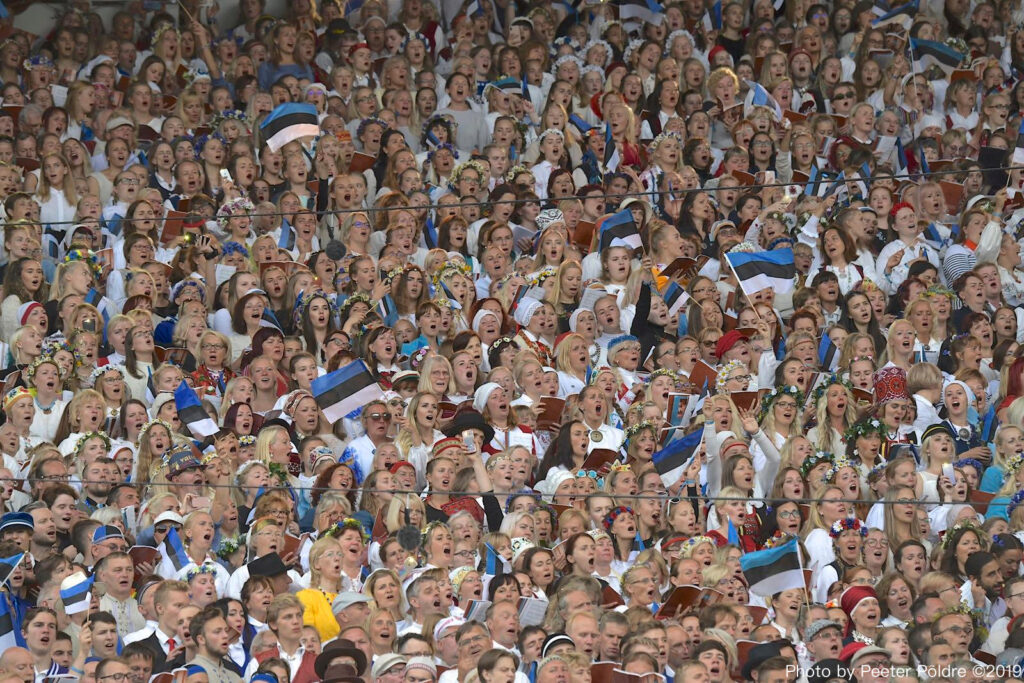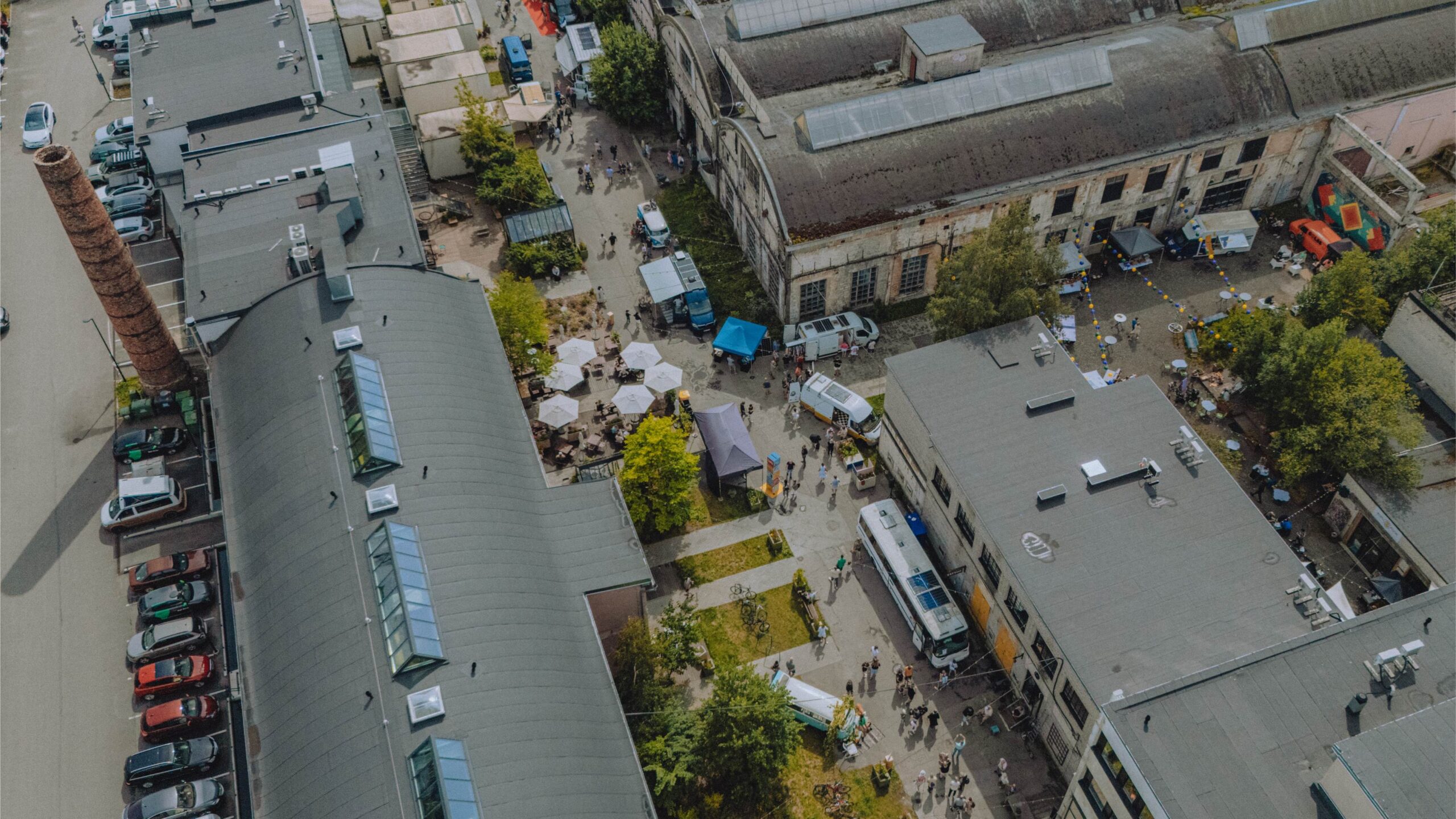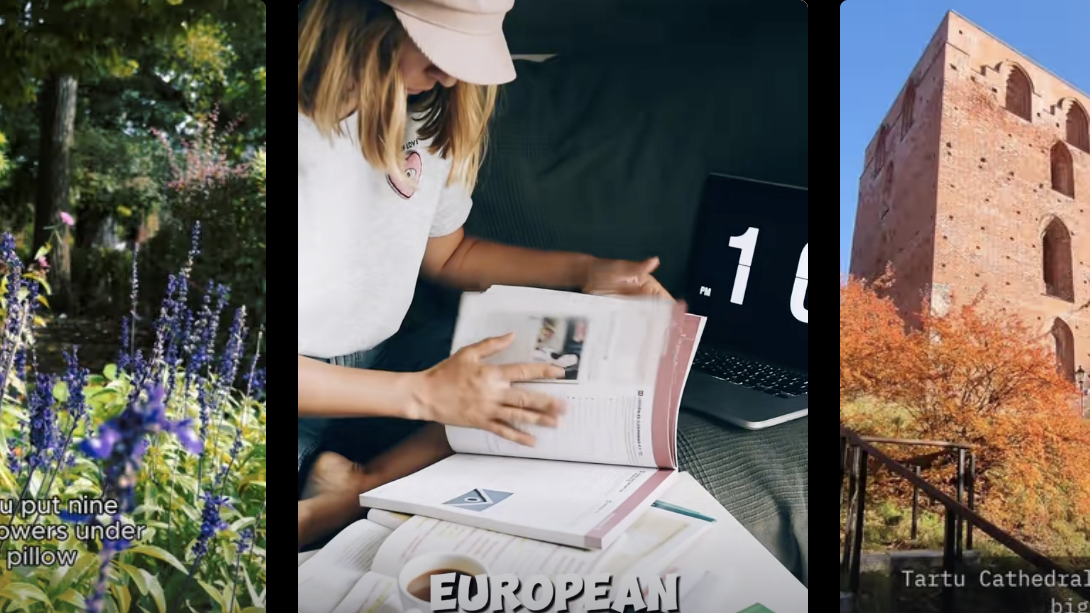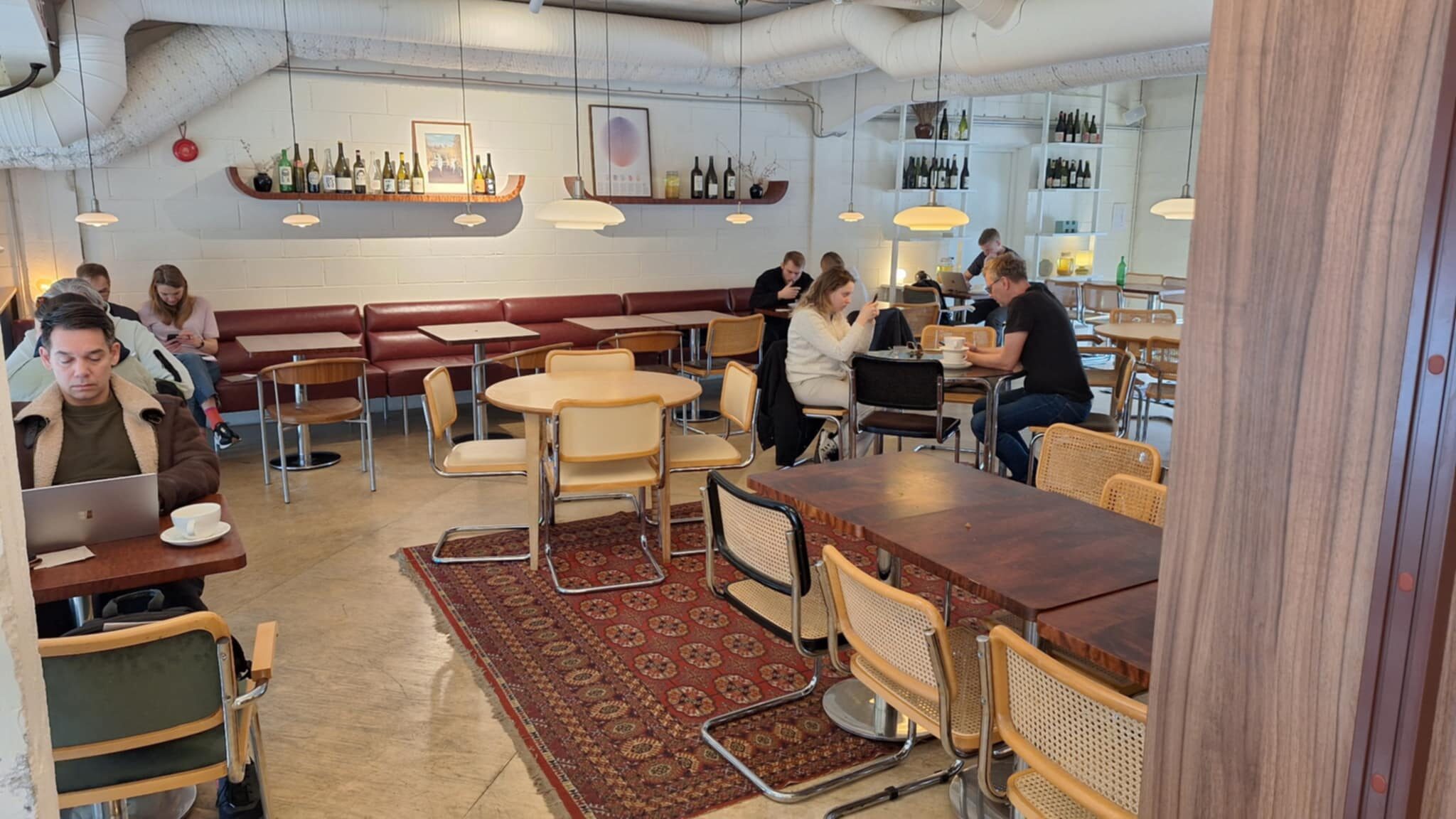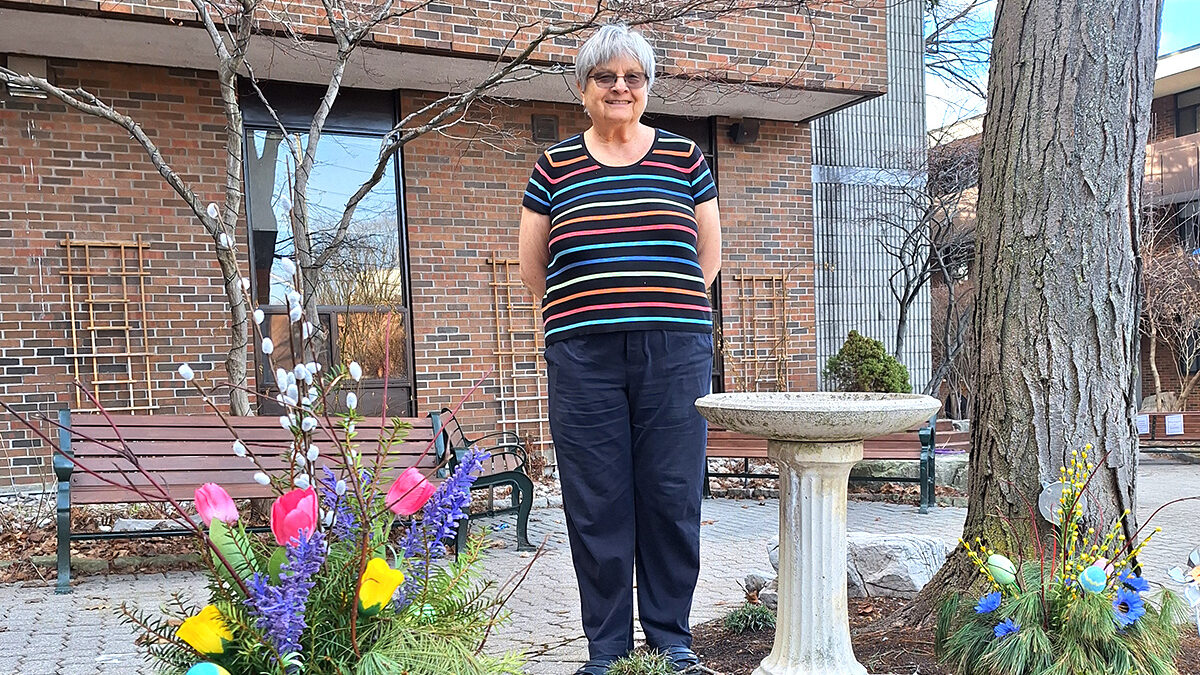Certainly, it’s a spectacle to see around 30,000 people singing on the stage of the Tallinn Song Festival Grounds. But try to envision singing along with them and 80,000 spectators. Over 100,000 people singing together in unison, with emotion and so much history behind each lyric and note. Talk about powerful.
And with the 28th Estonian Song Festival and 21st dance festival taking place from July 3rd to 6th of this year (with July 6th being the main concert of the song festival), there’s still time to learn some of the key songs that are performed, even if you’ve never heard them before. Let’s get started.
“Mu isamaa, mu õnn ja rõõm”: Naturally, Estonia’s national anthem (translated “My Fatherland, My Happiness and Joy”) is at the top of the list. It’s sung on so many occasions in Estonia and among Estonians abroad.
The anthem features lyrics by Johann Voldemar Jannsen—a figure of the Estonian National Awakening—and a melody by Finnish composer Fredrik Pacius. In each section, we hear proclamations of how beautiful the nation of Estonia is. A land that has given birth to and raised Estonians for millennia. The words are filled with gratitude and a promise of faithfulness. And finally, there is a plea that God watch over the homeland and bless its undertakings.
…sing with all of your might starting with the line “mis iial ette võtad sa”. This is the resounding conclusion of the song.
Dynamically, when singing the third section of the song, bring your voice down low for the first four lines (starting with “Su üle Jumal valvaku”) and then sing with all of your might starting with the line “mis iial ette võtad sa”. This is the resounding conclusion of the song.
Side note: you might be interested to know that the first four notes of the anthem have been played on intercoms at Tallinn Airport when announcements come on. See if you can hear it when you arrive and cross the border.
Lyrics (all lyrics compiled from laulud.ee):
Mu isamaa, mu õnn ja rõõm,
kui kaunis oled sa!
Ei leia mina iial teal
see suure laia ilma peal,
mis mul nii armas oleks ka,
kui sa, mu isamaa!
Sa oled mind ju sünnitand
ja üles kasvatand;
sind tänan mina alati
ja jään sull’ truuiks surmani!
Mul kõige armsam oled sa,
mu kallis isamaa!
Su üle Jumal valvaku,
mu armas isamaa!
Ta olgu sinu kaitseja
ja võtku rohkest’ õnnista’,
mis iial ette võtad sa,
mu kallis isamaa!
“Mu isamaa on minu arm”: This song, with lyrics by legendary poet Lydia Koidula, whose father was Johann Voldemar Jannsen, could be considered the unofficial second national anthem. It’s the final piece of music to be performed at each song festival.
In the lyrics, the sentiment of the Estonian national anthem is expanded upon. Estonia, the Fatherland, is a place to which one’s heart is given. And so, the same pains are felt. The same joys are felt. Estonia is anthropomorphized as a caring father figure who cradles his children in his arms. There is an unbreakable love communicated in each line, not even threatened by a thousand deaths. When you ponder the poetry of each of these songs, it makes extra sense of the expressions and tears shown in recordings of the festival.
lyrics:
Mu isamaa on minu arm,
kel südant annud ma.
sull’ laulan ma, mu ülem õnn,
mu õitsev Eestimaa!
Su valu südames mul keeb,
su õnn ja rõõm mind rõõmsaks teeb,
mu isamaa,
:,: mu isamaa! :,:
Mu isamaa on minu arm,
ei teda jäta ma.
Ja peaks sada surma ma
see pärast surema!
Kas laimab võõra kadedus,
sa siiski elad südames,
mu isamaa,
:,: mu isamaa! :,:
Mu isamaa on minu arm,
ja tahan puhata,
su rüppe heidan unele,
mu püha Eestimaa!
Su linnud und mull’ laulavad,
mu põrmust lilled õitsetad,
mu isamaa,
:,: mu isamaa! :,:
“Ta lendab mesipuu poole”: A song with especially rich, naturalistic imagery, “He Flies to the Beehive”, as it’s translated, paints the picture of a brave and hard-working bee, who seeks to return to their hive.
… the symbolism of the song has continued to apply to the lives of Estonians, up to its first performance at Laulupidu in 1999 and beyond.
It resonates strongly with the tragedies and oppression faced by Estonians throughout history, in the way it counts those who make it home and those who don’t through countless obstacles and danger. And it demonstrates a connection to the homeland: “kas kodus sa, kas võõral maal—/kuis ihkad isamaa poole!” (“Whether at home or in a foreign land—how you yearn for your homeland!”).
Composed by Peep Sarapik and set to a poem by Juhan Liiv that was first published in 1905, the symbolism of the song has continued to apply to the lives of Estonians, up to its first performance at Laulupidu in 1999 and beyond.
lyrics:
Ta lendab lillest lillesse
ja lendab mesipuu poole;
ja tõuseb kõuepilv ülesse,
ta lendab mesipuu poole.
Ja langevad teele tuhanded,
veel koju jõuavad tuhanded
ja viivad vaeva ja hoole
ja lendavad mesipuu poole.
Hing, oh hing, sa raskel a’al –
kuis õhkad isamaa poole;
kas kodu sa, kas võõral maal –
kuis ihkad isamaa poole!
Ja puhugu vastu sull’ surmatuul
ja lennaku vastu sull’ surmakuul:
sa unustad surma ja hoole
ning tõttad isamaa poole!
Hing, oh hing, sa raskel a’al –
kuis õhkad isamaa poole;
kas kodu sa, kas võõral maal –
:,: kuis ihkad isamaa poole! :,:
“Tuljak”: In addition to the most well-known patriotic songs, there is also a celebratory composition that’s traditionally heard at Estonian weddings, as part of a dance, live musical performance, or both. “Tuljak,” composed by Miina Härma and with lyrics by Karl Ferdinand Karlson, is a jubilant and mind-bogglingly complex composition. The dance starts to really test your coordination three quarters of the way in, as well, should one get the opportunity to dance it in one’s life.
The story told by the song has many details and “Easter eggs”, but in summary, it's a play-by-play of a major wedding celebration between Mann and Tõnn. Fifty barrels of vodka are rolled in. Rifles are fired. Mann and Tõnn crack jokes and make each other laugh hysterically. The whole family is dancing. And the men at the wedding look up sentimentally at the moon. There’s a lot that happens, see if you can keep up with all of the singing!
lyrics:
Terve vald oli kokku aetud,
kihelkond kokku kutsutud;
külalisi igat seltsi –
Viruvanem kaasagagi palutud!
Tõnni, parajam peiu,
kosind Mannikese endale,
Manni, nobedam neiu,
läheb Tõnnile mehele.
Pulmad, jah pulmad!
Pulmapidu ülitore.
Viina viiskümmend vaati,
pulma kraami kokku toodi
nõnda palju, kui saadi.
Parte, hanesid praeti
vist üle tuhande ära,
terve trobikond püssisid
pulma auks teeb kära.
Kas vahest kuu
meil kumab ju,
või näen päikest hiilg’va sära sees?
See on ju Tõnn, seal ka ta Mann –
kahekesi sammuvad nad käsi-käes.
Teeb nalja Mann,
siis naerab Tõnn,
nii et vesi veereb palgeilta.
Neil ilus ilm,
neil särab silm,
jõuaks nemad nõnda elust läbi ka!
Vennad, veeretage viru valssi,
meie tahaks minna tantsima.
Tublist’ helistage tuljaku tantsu,
see paneb vere kihama.
Pill sütitab meeli, tants keerutab pead,
poiss kutsub, memm tahab, et tantsima läed.
Kuid miks värised, hüppad nõnda, südameke sees,
kui kaenlasse vajutab meid mehine mees.
„Ärge häbenege, piigakesed, midagi meid,
meie võime ju omal ajal kosida teid.
Kena hobu hirnub tallis, tore saan on mul ka,
rikas talu, mille peremeheks pea saan ma.“
„Kuule armas languke!“
„Mis tahad, Tõnni taadike?“
„Tants on tubli, lõbus pilliviis!“
„Eks läheme ka tants’ma siis!“
Hõissa!
Tõnni taat viis Manni memme tantsima!
Taati memmega
Laskem elada!
“Koit”: Here’s one more song for good measure. Tõnis Mägi’s tune from the time of the Singing Revolution, “Koit” (“Dawn”) is hopeful and triumphant. A “royal glow,” a ray of light, is cast upon the land. He sings of joining forces, of a “common voice,” through which anything is possible. Mägi calls for listeners to cast off their servitude, to prepare for a renewal.
While we get plenty of hints, it’s not one-hundred percent explicit what this renewal is until the peak of the song when he sings “Laul, me võidulaul, kõlama see jääb/ peagi vaba Eestit sa näed!” (“The song, our victory song, will sound/ soon you will see a free Estonia!”).
lyrics:
On jälle aeg selg sirgu lüüa
ja heita endalt orjarüü,
et loomishoos kõik loodu
koos võiks sündida kui uuesti.
On koit, kuninglik loit,
valguse võit äratab maa.
Prii on taevapiir, esimene kiir
langemas me maale.
Hõik – murrame kõik,
et vabana saaks hingata taas.
Näe – on murdund jää
ulatagem käed, ühendagem väed.
Nõul, ühisel nõul,
ühisel jõul, me suudame kõik.
Ees on ainus tee, vabaduse tee
teist ei olla saagi.
Võim, valguse võim
priiuse hõim, läheme koos
huulil rõõmuhüüd
Näe, on kaljust käe kätte saanud hiid.
Usk edasi viib, taevane kiir
saatmas on meid
Nii – on võiduni jäänud veel üks samm
lühikene samm, samm.
Maa, isade maa, on püha see maa,
mis vabaks nüüd saab
Laul, me võidulaul, kõlama see jääb
peagi vaba Eestit sa näed!
Not only does the Laulu- ja tantsupidu YouTube channel have videos of performances that you can practice singing along with, there are instructional videos for performing songs from the festival repertoire on other instruments like violin, kannel, and diatonic accordion (lõõtspill).
So in addition to securing your tickets for the Estonian Song and Dance Festival and planning all of your flights, accommodation, and activities, don’t forget to also prepare your singing voice. Jog your memory when it comes to these melodies and lyrics and it’ll make for even better memories!
